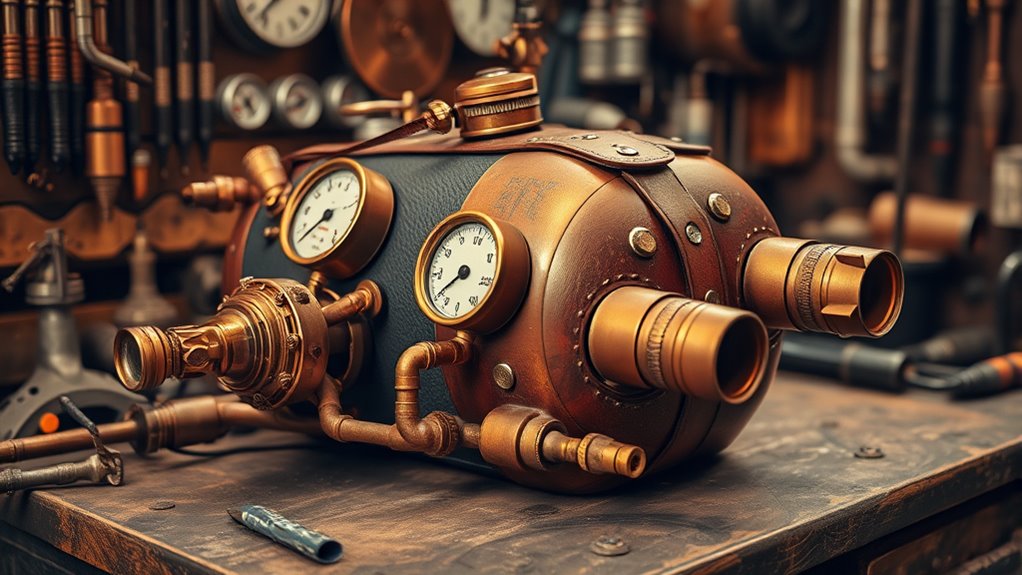To build a steampunk jetpack prop, start by sketching a vintage aeronautical design with steampunk details like rivets, gears, and brass fittings. Use lightweight materials such as foam or plywood for the main structure, then add aged metal, copper tubes, and leather straps for authenticity. Enhance the look with weathering techniques, faux steam components, and industrial accents. If you keep going, you’ll discover how to bring this unique, vintage-inspired device to life with detailed craftsmanship.
Key Takeaways
- Sketch a vintage aviation-inspired design with Victorian industrial details like rivets, gears, and pipes for authentic steampunk style.
- Select lightweight materials such as foam, plywood, brass, copper tubing, and aged wood for realistic construction.
- Incorporate faux steam mechanisms with painted gears, valves, and vents to simulate active steam-powered movement.
- Apply weathering techniques like patina, dry brushing, and washes to achieve a vintage, aged appearance.
- Assemble all components securely, ensuring stability and detailed finishing for a convincing, display-ready steampunk jetpack.

Creating a steampunk jetpack prop combines imaginative design with practical craftsmanship, giving you a striking accessory for costumes or displays. To achieve that authentic look, you’ll want to focus on incorporating steam powered mechanisms and vintage aviation aesthetics. These elements define the steampunk style, blending Victorian-era industrial design with futuristic fantasy. Start by sketching your concept, paying close attention to the shape and details that evoke early aviation devices. Think brass fittings, rivets, gears, and pipes—these are essential to capturing that vintage feel.
Craft a vintage-inspired steampunk jetpack with brass fittings, gears, pipes, and weathered finishes for authentic style.
Next, gather your materials. Brass or brass-colored metals, copper tubing, and aged-looking wood are excellent choices for a realistic finish. You might also want to include small pressure gauges, valves, and decorative vents to enhance the steam-powered vibe. For the main body, use lightweight foam or plywood, shaping it into a sleek, compact form that resembles a jetpack. Attach your metal components using strong adhesive or small screws, making sure everything is secure but maintains that handcrafted appearance.
The steam-powered mechanisms are the heart of your prop. You don’t need real steam—simply fake it with painted or faux-pressurized elements that suggest motion and power. For example, you could add small, rotating gears at the sides or on the back, giving the impression of active machinery. Paint these parts with metallic paints, then weather them with darker washes to create a worn, vintage look. Incorporate faux pipes and valves that look functional but are purely decorative. These elements should appear as if they could operate with steam pressure, adding to the authenticity.
To reinforce the vintage aviation aesthetic, add details reminiscent of old aircraft engines—like exhaust ports, propellers, or wing-like accents. Use leather straps or belts for mounting points, which lend both functionality and style. When painting, aim for a patina finish—think tarnished brass, rusted copper, and aged wood—that suggests years of use. Carefully weather your prop with dry brushing and washes, so it looks like a well-loved piece of machinery from a Victorian sci-fi world. Additionally, consider incorporating detailed craftsmanship to enhance realism and visual appeal.
Finally, assemble all parts with attention to balance and detail. Your goal is to create a convincing, visually compelling steampunk jetpack that looks like it could power a vintage airship or a daring explorer. With the right combination of steam powered mechanisms and vintage aviation aesthetics, your prop will stand out as a showcase of creativity and craftsmanship, perfect for cosplay, displays, or just as a conversation piece.
Frequently Asked Questions
What Safety Precautions Are Recommended During Construction?
You should prioritize safety by wearing fire-resistant coatings on flammable materials and guarantee proper electrical safety measures. Always work in a well-ventilated area, keep a fire extinguisher nearby, and avoid using live electricity without proper insulation. Use protective gear like gloves and goggles, and double-check wiring connections. Taking these precautions minimizes risks, keeps you safe, and helps you craft your steampunk jetpack prop responsibly.
Can This Prop Be Wearable for Extended Periods?
Yes, this prop can be wearable for extended periods if you focus on comfort. Make certain good weight distribution so it doesn’t strain your shoulders or back, and use lightweight materials where possible. Adjust straps for a snug fit to prevent shifting, and take breaks to avoid fatigue. Prioritizing wearable comfort helps you enjoy your steampunk adventure without discomfort or injury, making your experience more enjoyable and safe.
What Materials Are Best for Authentic Steampunk Aesthetics?
You should choose vintage metal parts, like brass or copper, to achieve an authentic steampunk look. Incorporate leather accents for added texture and an aged appearance. These materials not only look fantastic but also enhance durability, making your prop more believable and stylish. Combining vintage metal with leather accents creates a genuine steampunk aesthetic that stands out, ensuring your costume is both eye-catching and true to the genre.
How Do I Make the Jetpack Lightweight yet Durable?
To make your steampunk jetpack lightweight yet durable, you should use lightweight materials like aluminum or thin brass for the frame, which provide strength without adding bulk. Incorporate durable construction techniques such as reinforced joints and riveted seams to guarantee stability. Consider using foam or plastic components for decorative parts to cut weight, and finish with protective coatings to enhance longevity. This balance keeps your prop both authentic and practical.
Are There Any Legal Considerations for Creating Functional Jetpack Models?
You should definitely check airspace regulations before creating a functional jetpack model, as flying devices may require specific permits or approvals to guarantee safety and legal compliance. Also, be aware of copyright concerns if you’re using patented technology or copyrighted designs in your jetpack. Ignoring these legal considerations can lead to fines or legal action. Always research local laws and intellectual property rights to stay within legal boundaries.
Conclusion
As you step back, the jetpack gleams like a forgotten relic of the past, ready to take flight. Coincidentally, a gust of wind stirs the gears and brass, making it seem alive, as if it’s waiting for you to ignite its spirit. With a final glance, you realize that your creation isn’t just a prop—it’s a bridge between imagination and reality. Now, all that’s left is for you to take that leap into your steampunk adventure.









